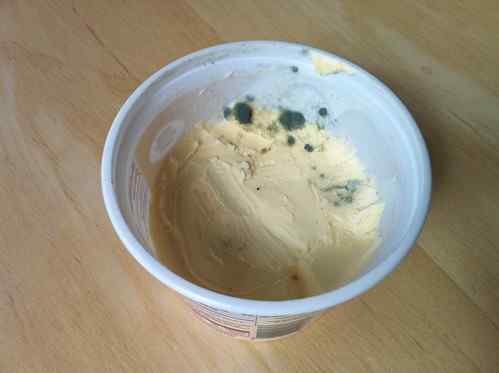You’re getting ready to bake your favorite treats when you notice some suspicious spots on your butter. Suddenly, you’re faced with a dilemma: should you ignore the mold and proceed with your recipe, or should you play it safe and find a fresh block of butter?
Moldy butter should never be consumed, as it can pose serious health risks, including food poisoning. Even if mold is only visible on a small portion of the butter, it’s best to discard the entire block or container, as mold spores can spread throughout the product undetected. When in doubt, always prioritize food safety.
But how does butter become moldy in the first place, and what can you do to keep your butter fresh for longer? Let’s find out.
What Causes Mold to Grow on Butter?
Mold grows on butter primarily due to improper storage conditions, such as exposure to air, moisture, or warm temperatures, which provide an ideal environment for spores to thrive.
When you leave butter unrefrigerated for extended periods or if it’s not sealed properly, you’re basically rolling out the welcome mat for mold. It’s not just about the visible surface either; microscopic mold spores are nearly everywhere, waiting for the perfect conditions to colonize.
Moisture is a big culprit here. Butter that’s been left out and exposed to air can collect moisture, especially in a humid environment.
This turns it into a breeding ground for mold. Similarly, storing butter in a warm place can accelerate mold growth. The warmer the conditions, the faster mold spores can grow and spread.
You might think that salted butter would be more resistant to mold due to its lower water content and the preservative nature of salt.
While it’s true that salted butter does spoil more slowly, it’s not immune. Mold can still develop if the storage conditions aren’t right.
Understanding these factors is important. By ensuring that your butter is stored correctly – cold, sealed, and dry – you can significantly reduce the risk of mold growth and keep your butter fresh and safe to eat for longer.
Is It Ever Safe to Eat Moldy Butter?

Understanding the causes of mold on butter lays the foundation for addressing whether it’s ever safe to consume once it has become moldy. Mold on butter signifies a significant change in its safety and quality.
It’s important to understand that consuming moldy butter is generally not safe and poses health risks due to the potential presence of mycotoxins, which are toxic substances produced by some molds.
Here’s a brief overview of considerations regarding moldy butter:
| Factor | Impact on Safety | Recommendation |
|---|---|---|
| Mold Type | Some molds produce toxins. | Avoid consumption. |
| Spread of Mold | Mold can penetrate deeper than visible. | Not safe to eat. |
| Storage Conditions | Improper storage increases risk. | Enhance storage practices. |
| Exposure Time | Longer exposure increases risk. | Discard if moldy. |
The presence of mold on butter indicates that it has been exposed to conditions favorable for mold growth, such as moisture and warmth. Given these risks, the safest course of action is to avoid consuming moldy butter altogether.
The health implications of ingesting moldy food can range from mild allergic reactions to more severe health risks, especially for individuals with compromised immune systems.
Can You Cut Off the Moldy Part and Eat the Rest?

While it might seem like a practical solution to simply remove the visible moldy spots from butter and consume the rest, this approach isn’t safe due to the microscopic nature of mold infiltration. Mold, a type of fungus, extends far beyond the areas visible to the naked eye.
It sends out tiny roots, or hyphae, deep into the food it colonizes. In the case of butter, which is a soft, porous substance, these hyphae can penetrate much deeper than you might expect, making it nearly impossible to remove all traces of contamination by merely cutting off the moldy part.
Additionally, certain molds produce mycotoxins, harmful substances that can pose health risks. These toxins can permeate into the butter far beyond the mold you see. Therefore, even if you remove the visibly affected area, there’s no guarantee the rest of the butter is safe to eat.
Given this risk, the safest course of action is to discard the entire stick or container of butter if you spot mold. This ensures you’re not inadvertently exposing yourself to potentially harmful substances. Always prioritize health and safety when dealing with moldy foods.
What Happens If You Eat Moldy Butter?

Given the risks associated with consuming moldy foods, it’s important to contemplate the potential health implications of eating moldy butter. If you inadvertently consume moldy butter, you might experience a range of symptoms.
Most commonly, people report mild food poisoning symptoms such as nausea, vomiting, and diarrhea. These reactions are your body’s way of expelling the unwanted substances.
Molds on butter can produce mycotoxins, which are toxic compounds potentially harmful to your health.
While a small, accidental ingestion of moldy butter mightn’t lead to severe health issues for most healthy individuals, it can pose a more significant risk for those with weakened immune systems, allergies to mold, or respiratory conditions.
In such cases, the consumption of moldy butter could lead to allergic reactions or respiratory distress.
It’s also worth noting that the visible mold might only be the tip of the iceberg. Mold can spread beneath the surface, and some types aren’t easily detectable by the naked eye. Consequently, even if you don’t immediately fall ill, consuming moldy food regularly could lead to long-term health issues.
Salted vs. Unsalted Butter: Which Molds Faster?
When considering mold growth on butter, it’s important to know that salted butter typically resists molding longer than unsalted varieties due to its salt content acting as a preservative.
Salt, a well-known antimicrobial agent, inhibits the growth of bacteria and molds, providing an additional layer of protection to the butter. This doesn’t mean salted butter is immune to mold, but it does have a longer shelf life when compared to its unsalted counterpart.
Unsalted butter, lacking this crucial preservative, is more susceptible to mold growth. This is particularly true if it’s stored in conditions that favor mold development, such as warm temperatures and high humidity.
If you’re a fan of unsalted butter for its pure, sweet cream flavor, it’s critical to store it properly. Refrigeration is a must, and for extended storage, consider freezing it.
Whether you prefer salted or unsalted, it’s essential to keep your butter in an airtight container or wrapped tightly to minimize exposure to air and moisture, both of which can accelerate mold growth.
Regularly inspect your butter for signs of mold, which can appear as fuzzy spots of various colors. If you spot mold, it’s safest to discard the affected portion, keeping in mind that mold can penetrate deeper than the surface.



